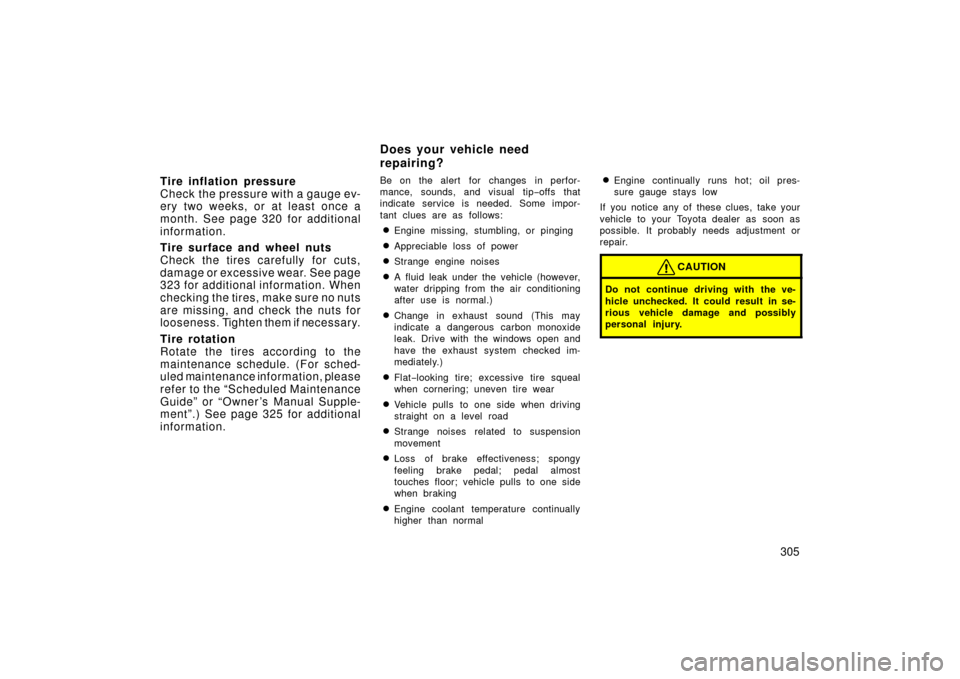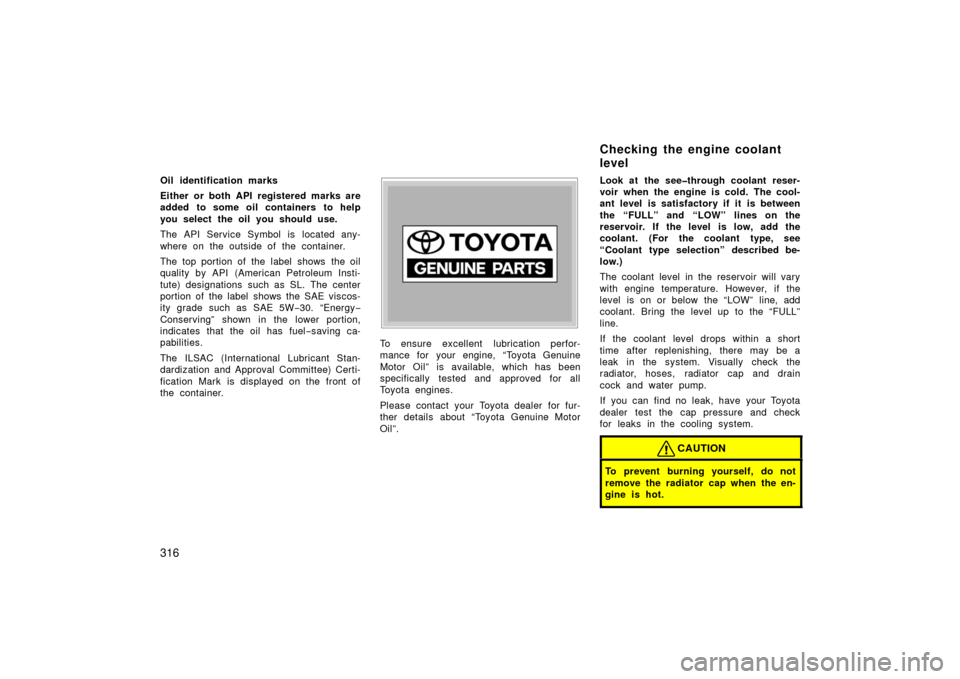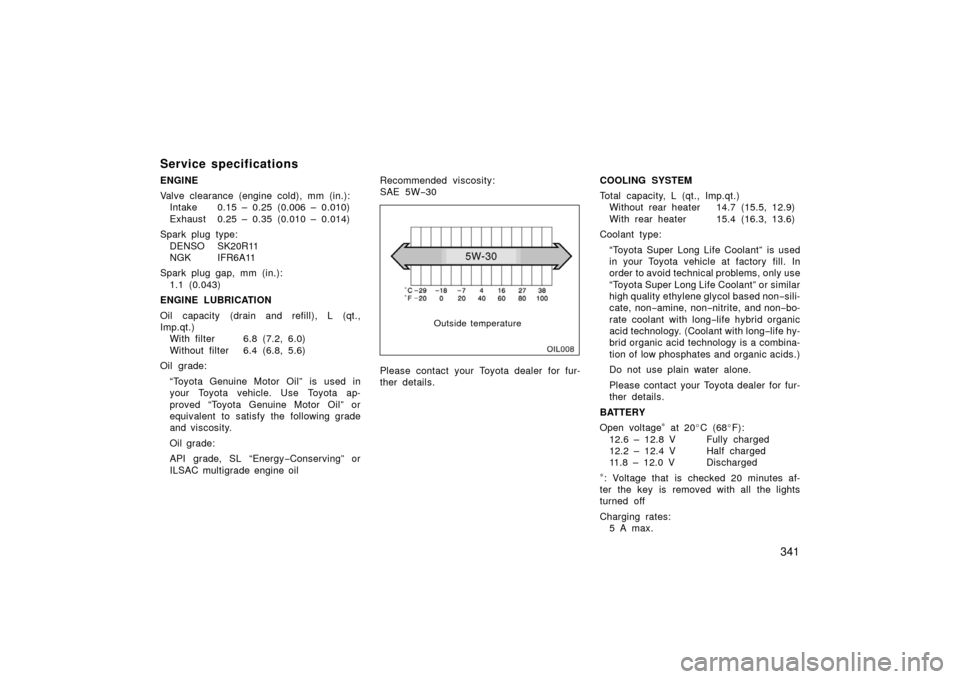Page 315 of 364

305
Tire inflation pressure
Check the pressure with a gauge ev-
ery two weeks, or at least once a
month. See page 320 for additional
information.
Tire surface and wheel nuts
Check the tires carefully for cuts,
damage or excessive wear. See page
323 for additional information. When
checking the tires, make sure no nuts
are missing, and check the nuts for
looseness. Tighten them if necessary.
Tire rotation
Rotate the tires
according to the
maintenance schedule. (For sched-
uled maintenance information, please
refer to the “Scheduled Maintenance
Guide” or “Owner ’s Manual Supple-
ment”.) See page 325 for additional
information.
Be on the alert for changes in perfor-
mance, sounds, and visual tip −offs that
indicate service is needed. Some impor-
tant clues are as follows:
�Engine missing, stumbling, or pinging
�Appreciable loss of power
�Strange engine noises
�A fluid leak under the vehicle (however,
water dripping from the air conditioning
after use is normal.)
�Change in exhaust sound (This may
indicate a dangerous carbon monoxide
leak. Drive with the windows open and
have the exhaust system checked im-
mediately.)
�Flat −looking tire; excessive tire squeal
when cornering; uneven tire wear
�Vehicle pulls to one side when driving
straight on a level road
�Strange noises related to suspension
movement
�Loss of brake effectiveness; spongy
feeling brake pedal; pedal almost
touches floor; vehicle pulls to one side
when braking
�Engine coolant temperature continually
higher than normal
�Engine continually runs hot; oil pres-
sure gauge stays low
If you notice any of these clues, take your
vehicle to your Toyota dealer as soon as
possible. It probably needs adjustment or
repair.
CAUTION
Do not continue driving with the ve-
hicle unchecked. It could result in se-
rious vehicle damage and possibly
personal injury.
Does your vehicle need
repairing?
Page 325 of 364
315
ENGINE OIL SELECTION
“Toyota Genuine Motor Oil” is used in
your Toyota vehicle. Use Toyota approved
“Toyota Genuine Motor Oil” or equivalent
to satisfy the following grade and viscos-
ity.
Oil grade:API grade, SL “Energy −Conserving” or
ILSAC multigrade engine oil
Recommended viscosity:
SAE 5W −30
Outside temperature
SAE 5W�30 is the best choice for good
fuel economy, and good starting in cold
weather.
If SAE 5W�30 oil is not available, SAE
10W�30 oil may be used. However, it
should be replaced with SAE 5W�30 at
the next oil change.
API service symbol
ILSAC certification mark
Page 326 of 364

316
Oil identification marks
Either or both API registered marks are
added to some oil containers to help
you select the oil you should use.
The API Service Symbol is located any-
where on the outside of the container.
The top portion of the label shows the oil
quality by API (American Petroleum Insti-
tute) designations such as SL. The center
portion of the label shows the SAE viscos-
ity grade such as SAE 5W−30. “Energy −
Conserving” shown in the lower portion,
indicates that the oil has fuel −saving ca-
pabilities.
The ILSAC (International Lubricant Stan-
dardization and Approval Committee) Certi-
fication Mark is displayed on the front of
the container.
To ensure excellent lubrication perfor-
mance for your engine, “Toyota Genuine
Motor Oil” is available, which has been
specifically tested and approved for all
Toyota engines.
Please contact your Toyota dealer for fur-
ther details about “Toyota Genuine Motor
Oil”. Look at the see�through coolant reser-
voir when the engine is cold. The cool-
ant level is satisfactory if it is between
the “FULL” and “LOW” lines on the
reservoir. If the level is low, add the
coolant. (For the coolant type, see
“Coolant type selection” described be-
low.)
The coolant level in the reservoir will vary
with engine temperature. However, if the
level is on or below the “LOW” line, add
coolant. Bring the level up to the “FULL”
line.
If the coolant level drops within a short
time after replenishing, there may be a
leak in the system. Visually check the
radiator, hoses, radiator cap and drain
cock and water pump.
If you can find no leak, have your Toyota
dealer test the cap pressure and check
for leaks in the cooling system.
CAUTION
To prevent burning yourself, do not
remove the radiator cap when the en-
gine is hot.
Checking the engine coolant
level
Page 351 of 364

341
Service specifications
ENGINE
Valve clearance (engine cold), mm (in.):Intake 0.15 – 0.25 (0.006 – 0.010)
Exhaust 0.25 – 0.35 (0.010 – 0.014)
Spark plug type: DENSO SK20R11
NGK IFR6A11
Spark plug gap, mm (in.): 1.1 (0.043)
ENGINE LUBRICATION
Oil capacity (drain and refill), L (qt.,
Imp.qt.) With filter 6.8 (7.2, 6.0)
Without filter 6.4 (6.8, 5.6)
Oil grade:
“Toyota Genuine Motor Oil” is used in
your Toyota vehicle. Use Toyota ap-
proved “Toyota Genuine Motor Oil” or
equivalent to satisfy the following grade
and viscosity.
Oil grade:
API grade, SL “Energy −Conserving” or
ILSAC multigrade engine oil Recommended viscosity:
SAE 5W
−30
Outside temperature
Please contact your Toyota dealer for fur-
ther details. COOLING SYSTEM
Total capacity, L (qt., Imp.qt.)
Without rear heater 14.7 (15.5, 12.9)
With rear heater 15.4 (16.3, 13.6)
Coolant type:
“Toyota Super Long Life Coolant” is used
in your Toyota vehicle at factory fill. In
order to avoid technical problems, only use
“Toyota Super Long Life Coolant” or similar
high quality ethylene glycol based non −sili-
cate, non −amine, non− nitrite, and non− bo-
rate coolant with long −life hybrid organic
acid technology. (Coolant with long −life hy-
brid organic acid technology is a combina-
tion of low phosphates and organic acids.)
Do not use plain water alone.
Please contact your Toyota dealer for fur-
ther details.
BATTERY
Open voltage
∗ at 20 �C (68 �F):
12.6 – 12.8 V Fully charged
12.2 – 12.4 V Half charged
11.8 – 12.0 V Discharged
∗: Voltage that is checked 20 minutes af-
ter the key is removed with all the lights
turned off
Charging rates: 5 A max.